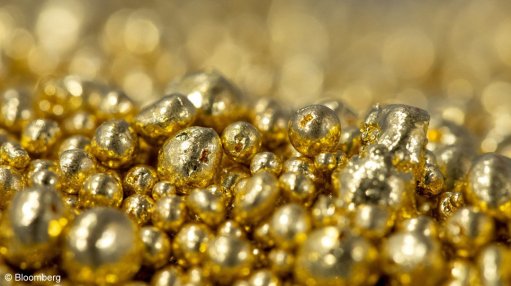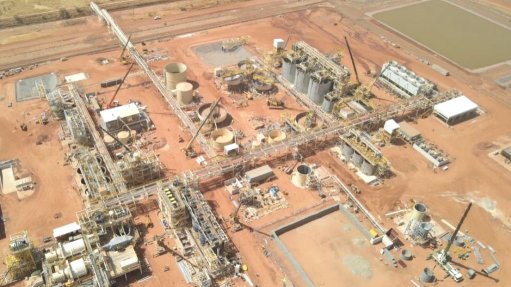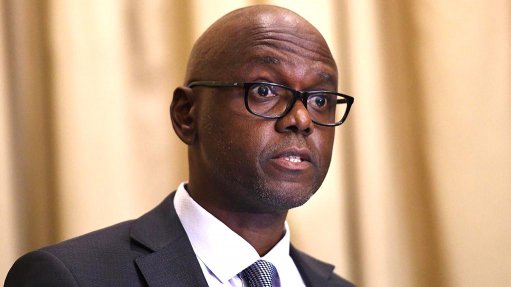Global iron-ore production growth to accelerate – BMI
Research firm BMI states that global iron-ore production growth will accelerate in the coming years, bringing an end to the stagnation that has persisted since iron-ore prices hit a decade-low average of $55/t in 2015.
BMI estimates global mine output growth will average 2.3% from 2023 to 2027, compared with -0.7% over the previous five years. This would lift yearly production by 372.8-millionn tonnes in 2027, compared with 2022 levels.
BMI also states that supply growth will primarily be driven by Brazil and Australia.
“Brazilian miner Vale has aggressive expansion plans, while miners in Australia, including BHP, Rio Tinto and Fortescue, will reinvest currently buoyant profits in additional production.
“We are already seeing greenfield mines ramping up production, like Fortescue's Iron Bridge and Rio Tinto's Gudai Darri,” BMI notes.
In Mainland China, iron-ore production will rise once again over the next three to four years as the market works to increase its self-sufficiency and reduce Australian imports, having declined over recent years.
As China's miners operate at the higher end of the iron-ore cost curve, and domestic ore grades continue to decline, BMI expects Mainland China-based firms to prioritise investment in overseas iron-ore mines, such as the enormous Simandou deposit, in Guinea.
Over the medium to long term, BMI expects lower prices will push production into stagnation as steel demand weakens in China.
The researcher also forecasts yearly production growth to average -0.1% from 2027 to 2032, with most producers seeing minimal increases or declines in some major suppliers such as Australia.
AUSTRALIA
BMI expects iron-ore production in Australia to grow at a yearly average of 0.2% from 2023 to 2027.
“The significant slowdown compared to the previous five years comes from the launch of the limited new sources of supply from new projects available. We expect a fall in output of 5.1-million tonnes in 2027 compared with 2023 levels.
“We believe Australia's seating at the lowest end of the global iron-ore cost curve will provide a healthy buffer against falling prices in the coming years.”
BMI notes that, on average, the cost of producing iron-ore in Australia is $30/t, compared with $40/t to $50/t in West Africa and $90/t in China.
Companies will continue to focus on higher-quality deposits in hopes of maintaining a competitive edge for 'green' steel production, BMI adds.
“Production growth will stagnate over the longer term and we expect production to peak around 2025 at just under one-billion tonnes. This production slowdown will be owing to mothballing of mines by junior miners and a pullback in capital expenditure by larger firms as iron-ore prices decline.”
BRAZIL
BMI expects Brazil’s iron-ore production growth to rebound in the coming years following contraction and stagnation from 2018 to 2020.
This owing to the fact that low operating costs, a solid project pipeline and Brazil's high-quality iron-ore – increasingly favoured by Chinese steel producers – will contribute to higher output.
“We forecast Brazil's iron-ore production to increase at a yearly average rate of 3.4% year-on-year from this year to 2027, rising from 56.1-million tonnes to 482.9-million tonnes.
“Production growth will slow over the long term and we forecast average yearly growth of 1.2% from 2027 to 2032, which would take yearly output to 507.5-million tonnes by 2032.”
BMI also expects the Serra Norte mining area’s Gelado project to ramp up production this year, while the N3 project has start ups expected in 2024.
“Its ongoing S11D project already boosted production in the first three quarters of the current financial year, resulting in a 5.8% year-on-year increase in iron-ore production, reaching 66.7-million tonnes.
“The project is on track to add 30-million tonnes of production capacity a year. On a whole, its huge iron-ore reserves in the Carajas mines offer immense upside to future production potential.”
MAINLAND CHINA
BMI states that China’s iron-ore production is set to increase in the next three to four years as it aims to reduce its dependency on Australian imports and be subjected to volatile prices.
The government set a 30% increase in production output as of December 2021.
BMI expects growth to reach 1.07-billion tonnes in 2025 before decreasing. Growth in output will be restricted by weak iron-ore prices, tightening environmental regulations and China’s expansion of offshore mine investments.
“China's iron-ore sector will become increasingly consolidated. This is owing to high costs of mining low-grade ore and environmental regulations in China that will eventually see the phasing out of iron-ore used in the production of steel as electric arc furnaces, with decarbonised steel taking precedence.”
According to Bloomberg, around 70% of Chinese iron-ore output is uneconomical at prices below $96/t. In particular, miners operating in provinces such as Hebei, Fujian, Guangdong and Xinjiang will take the strain of lower prices owing to their sitting at the highest end of the iron-ore cost curve, BMI adds.
“We expect that a weaker short-term price environment per our updated forecast is unlikely to drive production down immediately. This is despite where these miners sit on the cost because of political incentives to support the industry, reach targets increasing domestic output, and reduce import dependence on production from Australia.”
INDIA
India’s iron-ore production growth will be limited by its export taxes on low-grade iron-ore lumps and fines, BMI adds.
“Last year, export taxes were raised to 50% and taxes on pellets were raised to 45% in an effort to meet local demand needs. The higher prices caused shipment to fall drastically amid a global low growth environment before being reversed late last year.”
BMI also points out that India’s largest iron-ore producer NMDC saw productions slumping to a two-year low of 2.05-million tonnes in August last year amid falling demand caused by taxes.
As of early this year, NMDC's iron-ore production has improved significantly, rising 11.4% year-on-year to 3.51-million tonnes in April.
“The country is expected to see rising production levels in future years, with NMDC having surpassed 40-million tonnes of production in both the 2022 and 2023 financial years.
“However, a reintroduction of export taxes will definitely hamper production growth should they implement it again in the near-term.”
Comments
Press Office
Announcements
What's On
Subscribe to improve your user experience...
Option 1 (equivalent of R125 a month):
Receive a weekly copy of Creamer Media's Engineering News & Mining Weekly magazine
(print copy for those in South Africa and e-magazine for those outside of South Africa)
Receive daily email newsletters
Access to full search results
Access archive of magazine back copies
Access to Projects in Progress
Access to ONE Research Report of your choice in PDF format
Option 2 (equivalent of R375 a month):
All benefits from Option 1
PLUS
Access to Creamer Media's Research Channel Africa for ALL Research Reports, in PDF format, on various industrial and mining sectors
including Electricity; Water; Energy Transition; Hydrogen; Roads, Rail and Ports; Coal; Gold; Platinum; Battery Metals; etc.
Already a subscriber?
Forgotten your password?
Receive weekly copy of Creamer Media's Engineering News & Mining Weekly magazine (print copy for those in South Africa and e-magazine for those outside of South Africa)
➕
Recieve daily email newsletters
➕
Access to full search results
➕
Access archive of magazine back copies
➕
Access to Projects in Progress
➕
Access to ONE Research Report of your choice in PDF format
RESEARCH CHANNEL AFRICA
R4500 (equivalent of R375 a month)
SUBSCRIBEAll benefits from Option 1
➕
Access to Creamer Media's Research Channel Africa for ALL Research Reports on various industrial and mining sectors, in PDF format, including on:
Electricity
➕
Water
➕
Energy Transition
➕
Hydrogen
➕
Roads, Rail and Ports
➕
Coal
➕
Gold
➕
Platinum
➕
Battery Metals
➕
etc.
Receive all benefits from Option 1 or Option 2 delivered to numerous people at your company
➕
Multiple User names and Passwords for simultaneous log-ins
➕
Intranet integration access to all in your organisation
















